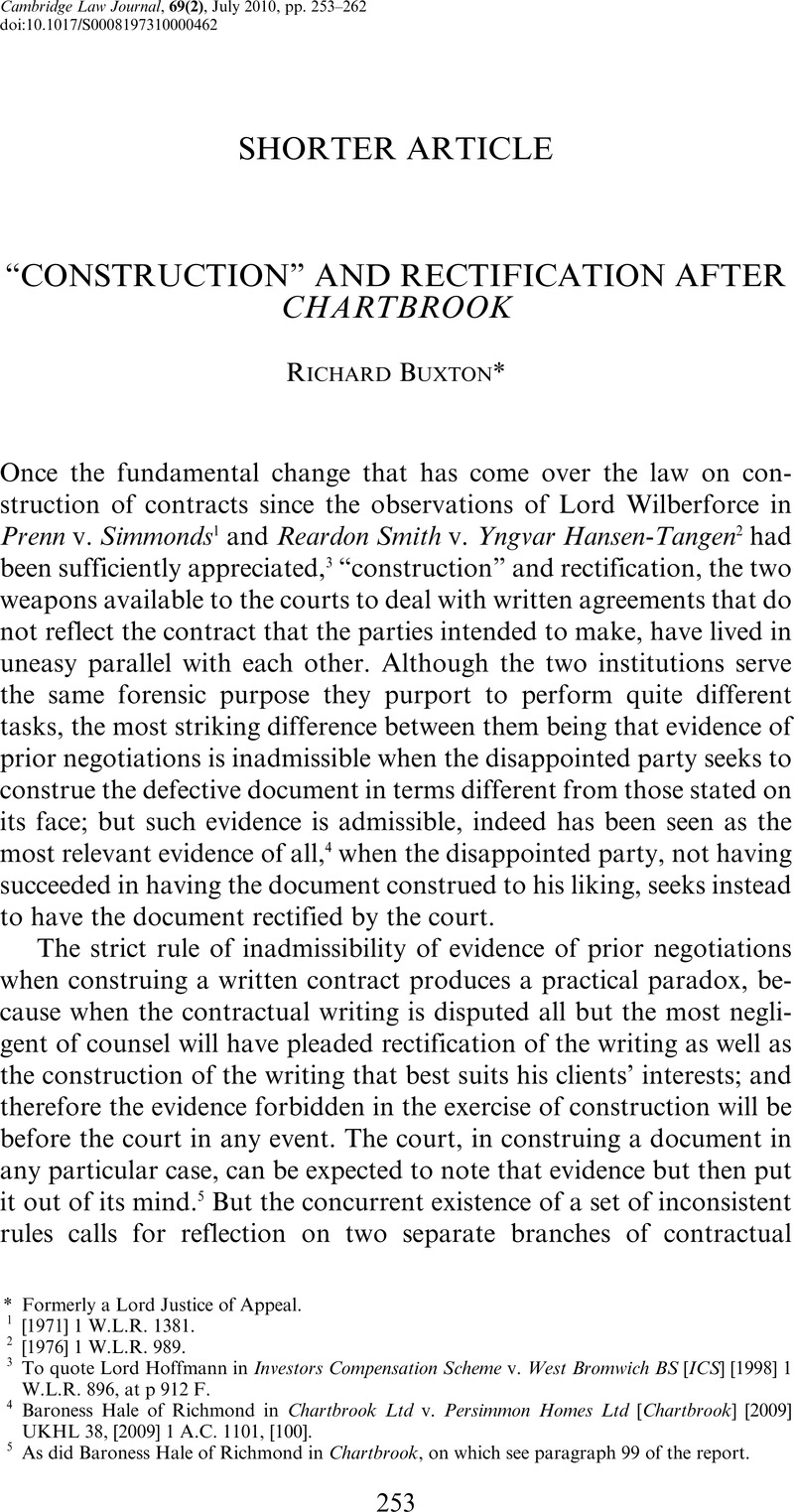Article contents
“CONSTRUCTION” AND RECTIFICATION AFTER CHARTBROOK
Published online by Cambridge University Press: 11 June 2010
Abstract

- Type
- Shorter Articles
- Information
- Copyright
- Copyright © Cambridge Law Journal and Contributors 2010
References
1 [1971] 1 W.L.R. 1381.
2 [1976] 1 W.L.R. 989.
3 To quote Lord Hoffmann in Investors Compensation Scheme v. West Bromwich BS [ICS] [1998] 1 W.L.R. 896, at p 912 F.
4 Baroness Hale of Richmond in Chartbrook Ltd v. Persimmon Homes Ltd [Chartbrook] [2009] UKHL 38, [2009] 1 A.C. 1101, [100].
5 As did Baroness Hale of Richmond in Chartbrook, on which see paragraph 99 of the report.
6 The editor of the Law Reports reasonably took that assurance at face value, and placed the case only in Volume One of the Weekly Law Reports.
7 [1998] 1 W.L.R. at 912H-913E.
8 Sir Kim Lewison, The Construction of Contracts 4th ed, (London 2007), p 3.
9 The extensive judicial observations on that issue are fully surveyed in Lewison, op. cit., paragraph 1.02.
10 Prenn v. Simmonds, [1971] 1 W.L.R. at p 1388.
11 Reardon Smith, [1976] 1 W.L.R. at p 998.
12 As Lord Hoffmann himself implicitly recognised when, in paragraph 37 of his speech in Chartbrook, he stressed the otherwise uncontroversial nature of the ICS principles.
13 ICS [1998] 1 W.L.R. at p 913 B-D.
14 [1997] A.C.749.
15 In paragraph 22 of Chartbrook support appears also to be sought from the observation of Brightman L.J. in East v. Pantiles (Plant Hire) Ltd [1982] 2 E.G.L.R. 111 at 112, there set out. But while Brightman L.J., read in abstraction from the case itself, appears to speak generally of correcting mistakes on the face of the instrument, he was addressing what was claimed to be, but found by the Court of Appeal not to have been, a clerical error. Whether there had indeed been a clerical error was determined entirely from looking at other clauses in the lease. Lord Brightman might have been surprised to be told that during that exercise he was not only entitled but also obliged to have regard to absolutely anything which would have affected the way in which the language of the document would have been understood by a reasonable man.
16 [1974] A.C. 235 at p 263.
17 As pointed out by Professor McLauchlan, (2010) 126 L.Q.R. at p 10, lately given a new lease of life by the emphasis placed in Chartbrook by both Lord Hope of Craighead and Lord Hoffmann on Inglis v. Buttery (1878) LR 3 App. Cas. 552 HL.
18 E.g. 30th edition (2009) at paragraph 5–107.
19 Oliver, Slade and Robert Goff L.JJ.
20 [1984] 1 Lloyds Reports 353 at p 359.
21 (2007) 123 L.Q.R. 116. The issue had also been considered, after the publication of Mr Smith's article, by Christopher Clarke J. in his, with respect, admirable judgment in P.T. Berlin Laju Tanker TBK v. Nuse Shipping Ltd [2008] EWHC 1330 (Comm); [2008] 2 Lloyd's Rep 246. The judge reached the same conclusion as Mr Smith without having the benefit of citation of the latter's article. The judgment, which examines the same authorities in the same terms as did the House of Lords in Chartbrook, was cited to the House, but not referred to in the speeches.
22 To quote Lord Hoffmann's statement of the argument, at paragraph 57 of Chartbrook.
23 First amongst them Professor McLauchlan in the note referred to in n 17 above, which draws on his earlier and, with respect, very valuable contributions to the subject. Of particular interest in the present context is Professor McLauchlan's powerful demonstration that most of the reasoning in support of the exclusionary rule by the same token undermines principle 5 in ICS.
24 (2005) 121 L.Q.R. at p 588.
25 Chartbrook, at paragraph 33.
26 Ibid, at paragraph 38.
27 See the text at n 24 above.
28 Chartbrook at paragraph 100.
29 See the passage from paragraph 38 of Chartbrook cited at n 26 above.
30 See The Nai Genova cited at n 20 above.
31 See in particular the tribute to the argument paid by Baroness Hale of Richmond at paragraph 101 of Chartbrook.
32 For extensive further complaints on this theme see Buxton (2009) 125 L.Q.R. 60. Baroness Hale of Richmond, at paragraph 101 of Chartbrook, saw it as the great strength of the common law that questions of great practical and theoretical importance in the law of contract were still open to debate and development. There are certainly some areas of the common law, such as tort or human rights, where justice requires the courts to be able to develope the law in the course of litigation. But the law of contract, which individuals and businessmen use to regulate their affairs in order to avoid litigation, should place a premium on certainty. Neither ICS nor Chartbrook achieve that end.
33 A length of time of the order that elapsed between Prenn v. Simmonds and the reversion to the issue in Chartbrook. Lord Hope in paragraph 2 of Chartbrook pointed out that under the common law “every so often” fundamental rules should come under fresh scrutiny. He gave no indication that the fresh scrutiny brought to bear in Chartbrook had been in any way overdue.
34 See paragraphs 14 and 25 in Chartbrook, referred to above.
35 See n. 28 above.
36 The expression of Lord Hoffmann, Chartbrook at paragraph 41.
- 7
- Cited by


